tow LINCOLN NAVIGATOR 2007 Service Manual
[x] Cancel search | Manufacturer: LINCOLN, Model Year: 2007, Model line: NAVIGATOR, Model: LINCOLN NAVIGATOR 2007Pages: 312, PDF Size: 2.74 MB
Page 221 of 312
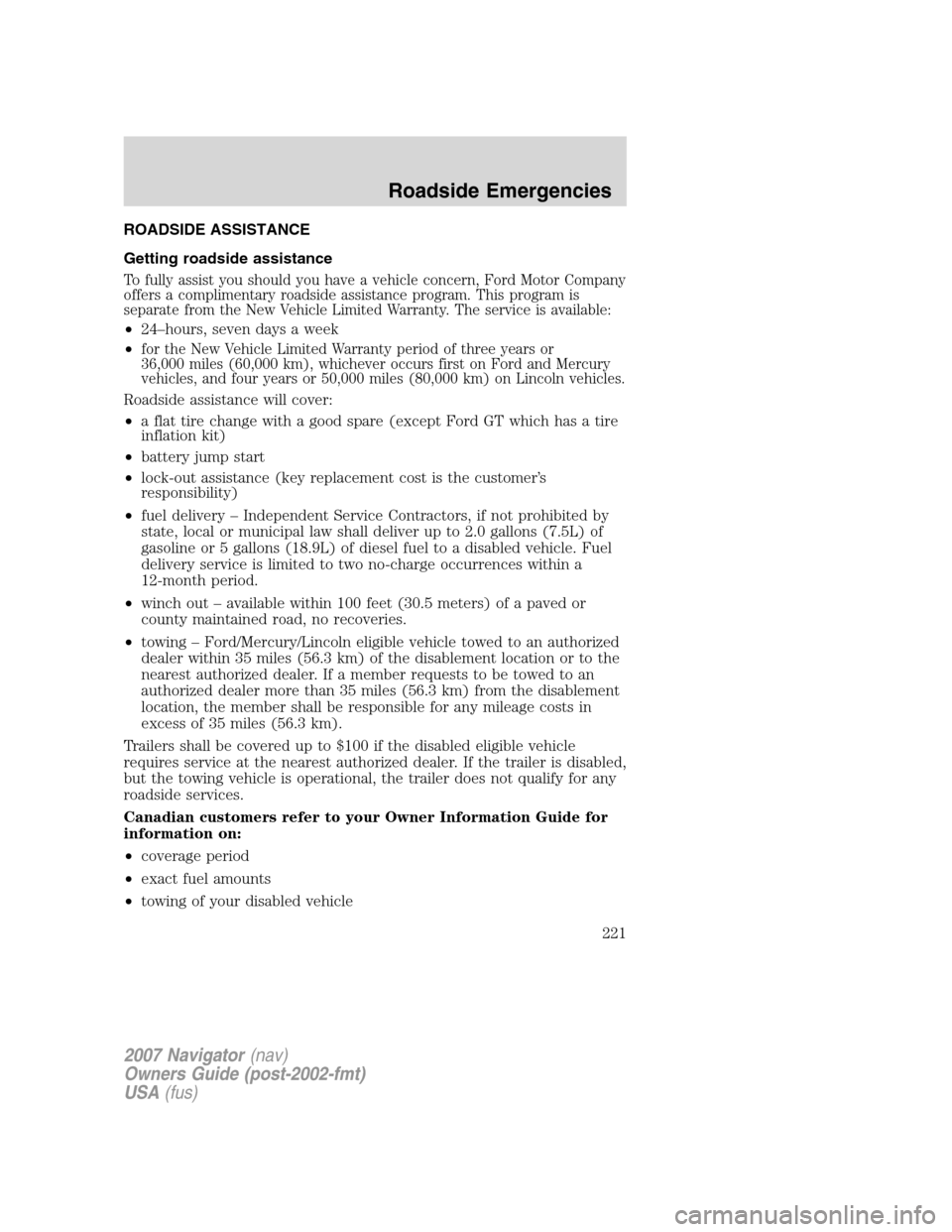
ROADSIDE ASSISTANCE
Getting roadside assistance
To fully assist you should you have a vehicle concern, Ford Motor Company
offers a complimentary roadside assistance program. This program is
separate from the New Vehicle Limited Warranty. The service is available:
•24–hours, seven days a week
•
for the New Vehicle Limited Warranty period of three years or
36,000 miles (60,000 km), whichever occurs first on Ford and Mercury
vehicles, and four years or 50,000 miles (80,000 km) on Lincoln vehicles.
Roadside assistance will cover:
•a flat tire change with a good spare (except Ford GT which has a tire
inflation kit)
•battery jump start
•lock-out assistance (key replacement cost is the customer’s
responsibility)
•fuel delivery – Independent Service Contractors, if not prohibited by
state, local or municipal law shall deliver up to 2.0 gallons (7.5L) of
gasoline or 5 gallons (18.9L) of diesel fuel to a disabled vehicle. Fuel
delivery service is limited to two no-charge occurrences within a
12-month period.
•winch out – available within 100 feet (30.5 meters) of a paved or
county maintained road, no recoveries.
•towing – Ford/Mercury/Lincoln eligible vehicle towed to an authorized
dealer within 35 miles (56.3 km) of the disablement location or to the
nearest authorized dealer. If a member requests to be towed to an
authorized dealer more than 35 miles (56.3 km) from the disablement
location, the member shall be responsible for any mileage costs in
excess of 35 miles (56.3 km).
Trailers shall be covered up to $100 if the disabled eligible vehicle
requires service at the nearest authorized dealer. If the trailer is disabled,
but the towing vehicle is operational, the trailer does not qualify for any
roadside services.
Canadian customers refer to your Owner Information Guide for
information on:
•coverage period
•exact fuel amounts
•towing of your disabled vehicle
2007 Navigator(nav)
Owners Guide (post-2002-fmt)
USA(fus)
Roadside Emergencies
221
Page 225 of 312

Passenger compartment fuse panel
The fuse panel is located under the right-hand side of the instrument panel.
To remove the trim panel for access
to the fuse box, pull the panel
toward you and swing it out away
from the side and remove it. To
reinstall it, line up the tabs with the
grooves on the panel, then push it
shut.
To remove the fuse box cover, press in the tabs on both sides of the
cover, then pull the cover off.
To reinstall the fuse box cover, place the top part of the cover on the
fuse panel, then push the bottom part of the cover until you hear it click
shut. Gently pull on the cover to make sure it is seated properly.
2007 Navigator(nav)
Owners Guide (post-2002-fmt)
USA(fus)
Roadside Emergencies
225
Page 227 of 312

Fuse/Relay
LocationFuse Amp
RatingPassenger Compartment Fuse
Panel Description
23 15A High beam headlamps
24 20A Horn relay
25 10A Demand lamps
26 10A Instrument panel cluster
27 20A Ignition switch
28 5A Radio
29 5A Instrument panel cluster
30 5A Not used (Spare)
31 10A Compass, Automatic dimming rear
view mirror
32 10A Restraints control module
33 10A Ebrake
34 5A Not used (spare)
35 10A Rear park assist, 4x4
36 5A PATS transceiver
37 10A Climate control
38 20A
Subwoofer/Amp (Audiophile radio)
39 20A Radio
40 20A Instrument panel amp, DSP,
Radio, 4x4 module
41 15A Radio
42 10A Upfitter relay coil, Trailer tow,
Battery charge coil
43 10A Rear wiper logic
44 10A Customer access feed
45 5A Front wiper logic
46 7.5A Not used (Spare)
47 30A Circuit
BreakerPower windows, Moon roof
48 — Delayed accessory relay
Note:Relays R301–R305 are not serviceable components; see your
authorized dealer for assistance.
2007 Navigator(nav)
Owners Guide (post-2002-fmt)
USA(fus)
Roadside Emergencies
227
Page 228 of 312

Power distribution box
The power distribution box is located in the engine compartment. The
power distribution box contains high-current fuses that protect your
vehicle’s main electrical systems from overloads.
Always disconnect the battery before servicing high current
fuses.
To reduce risk of electrical shock, always replace the cover to
the Power Distribution Box before reconnecting the battery or
refilling fluid reservoirs.
If the battery has been disconnected and reconnected, refer to the
Batterysection of theMaintenance and Specificationschapter.
The high-current fuses are coded as follows:
Fuse/Relay
LocationFuse Amp
RatingPower Distribution Box
Description
1 — Blower relay
2 — Not used
3 — Rear window defroster relay
4 30A** Third row seats (driver side)
5 40A** Trailer tow connector (electric
brake)
6 60A ** ABS (valves)
2007 Navigator(nav)
Owners Guide (post-2002-fmt)
USA(fus)
Roadside Emergencies
228
Page 229 of 312
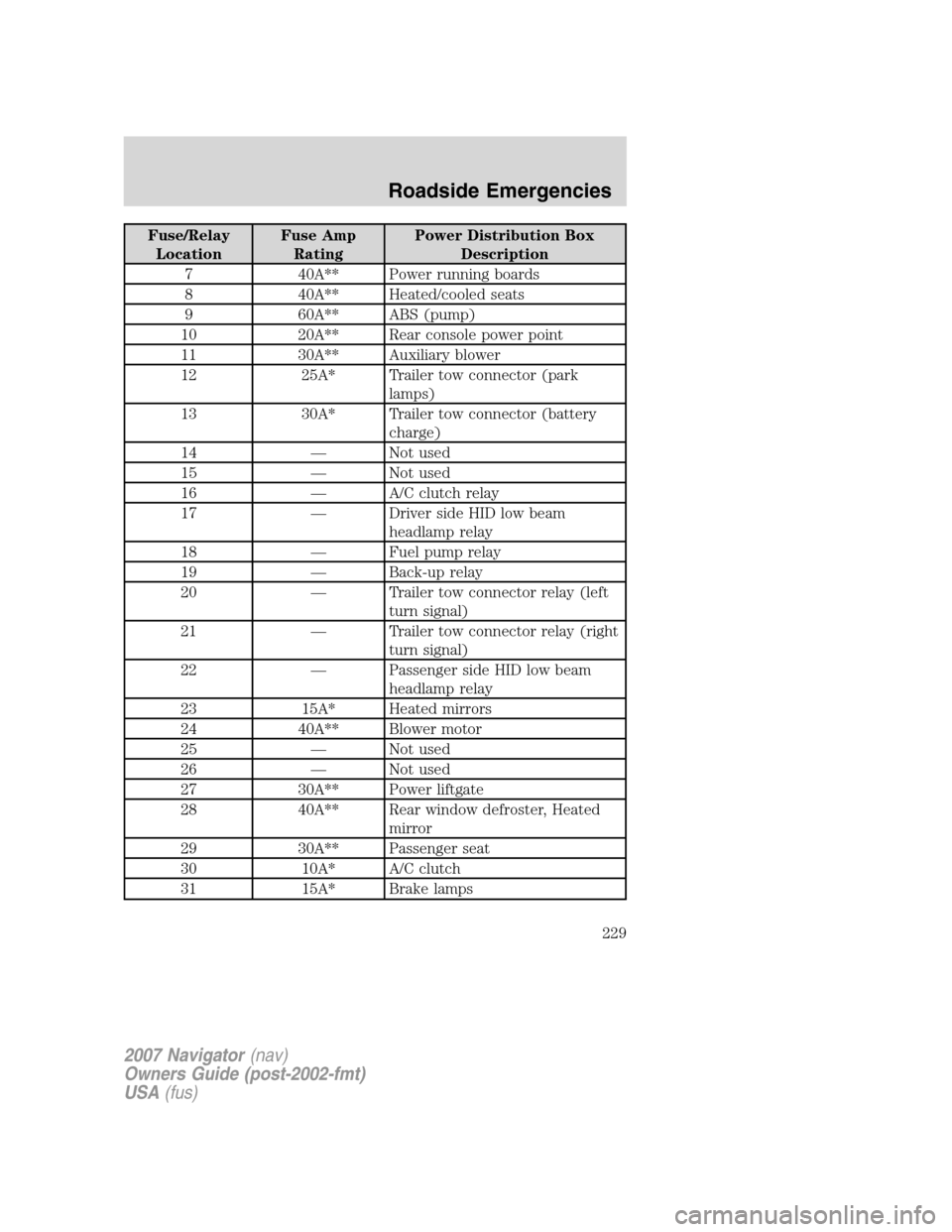
Fuse/Relay
LocationFuse Amp
RatingPower Distribution Box
Description
7 40A** Power running boards
8 40A** Heated/cooled seats
9 60A** ABS (pump)
10 20A** Rear console power point
11 30A** Auxiliary blower
12 25A* Trailer tow connector (park
lamps)
13 30A* Trailer tow connector (battery
charge)
14 — Not used
15 — Not used
16 — A/C clutch relay
17 — Driver side HID low beam
headlamp relay
18 — Fuel pump relay
19 — Back-up relay
20 — Trailer tow connector relay (left
turn signal)
21 — Trailer tow connector relay (right
turn signal)
22 — Passenger side HID low beam
headlamp relay
23 15A* Heated mirrors
24 40A** Blower motor
25 — Not used
26 — Not used
27 30A** Power liftgate
28 40A** Rear window defroster, Heated
mirror
29 30A** Passenger seat
30 10A* A/C clutch
31 15A* Brake lamps
2007 Navigator(nav)
Owners Guide (post-2002-fmt)
USA(fus)
Roadside Emergencies
229
Page 230 of 312
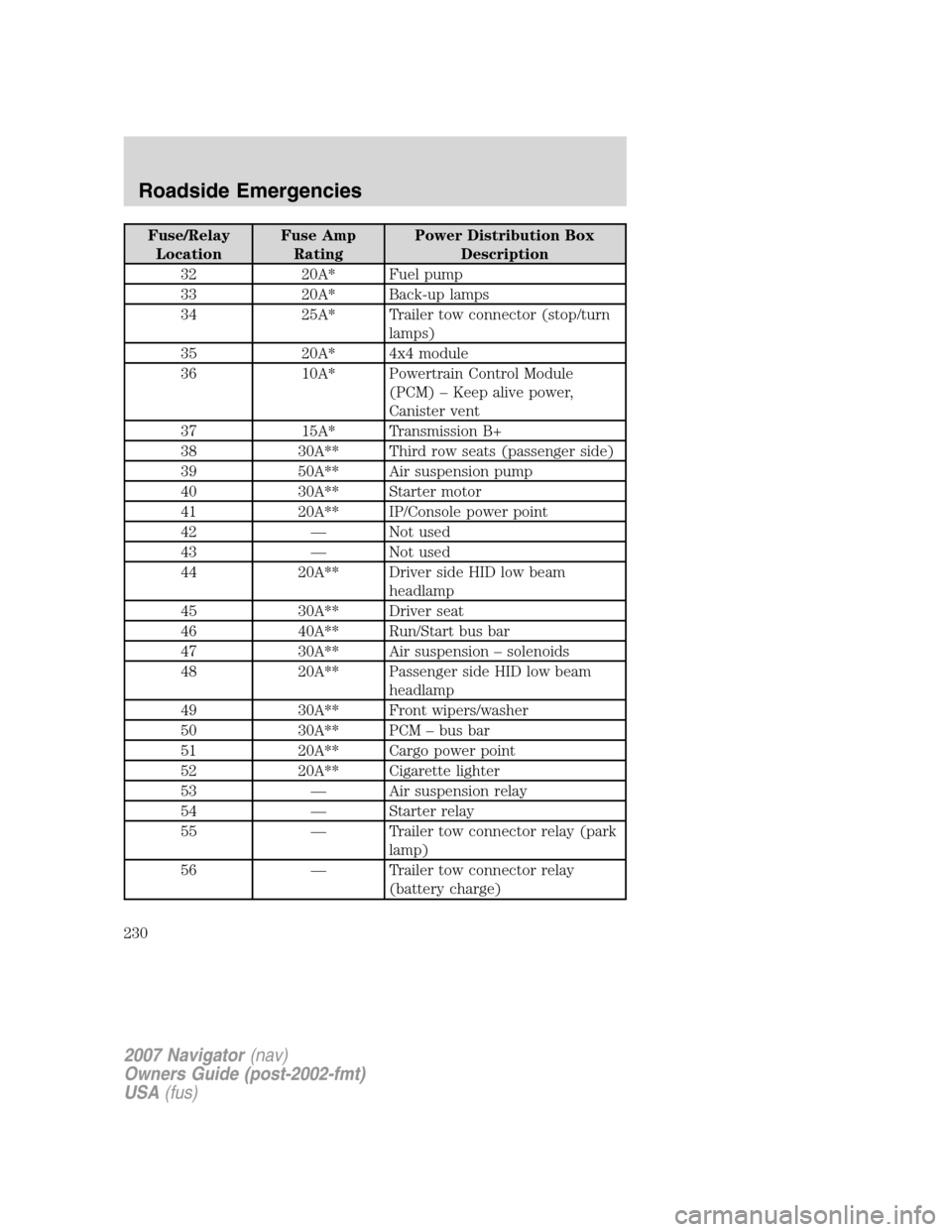
Fuse/Relay
LocationFuse Amp
RatingPower Distribution Box
Description
32 20A* Fuel pump
33 20A* Back-up lamps
34 25A* Trailer tow connector (stop/turn
lamps)
35 20A* 4x4 module
36 10A* Powertrain Control Module
(PCM) – Keep alive power,
Canister vent
37 15A* Transmission B+
38 30A** Third row seats (passenger side)
39 50A** Air suspension pump
40 30A** Starter motor
41 20A** IP/Console power point
42 — Not used
43 — Not used
44 20A** Driver side HID low beam
headlamp
45 30A** Driver seat
46 40A** Run/Start bus bar
47 30A** Air suspension – solenoids
48 20A** Passenger side HID low beam
headlamp
49 30A** Front wipers/washer
50 30A** PCM – bus bar
51 20A** Cargo power point
52 20A** Cigarette lighter
53 — Air suspension relay
54 — Starter relay
55 — Trailer tow connector relay (park
lamp)
56 — Trailer tow connector relay
(battery charge)
2007 Navigator(nav)
Owners Guide (post-2002-fmt)
USA(fus)
Roadside Emergencies
230
Page 231 of 312

Fuse/Relay
LocationFuse Amp
RatingPower Distribution Box
Description
57 — Run/Start relay
58 — Not used
59 — PCM relay
60 — Not used
61 — A/C clutch diode
62 — Fuel pump diode
63 15A* Trailer tow connector (back-up
lamp)
64 — Not used
65 10A* Air suspension logic
66 — Not used
67 10A* Blower coil
68 — Not used
69 30A* Run/Start – passenger
compartment fuse panel
70 20A* PCM (sensors) – EFC, A/C clutch
coil
71 5A* Fuel coil, ISP-R
72 20A* PCM (ignition coils)
73 5A* Transmission ignition
74 20A* PCM (sensors) – HEGO/CMS,
MAFS, EVMV, CMCV, Speed
deactivation switch, VCT
75 5A* 4x4 Integrated Wheel Ends
(IWE) solenoid
76 20A* PCM – VPWR
77 10A* ABS logic, Heated PCV
* Mini Fuses ** Cartridge Fuses
2007 Navigator(nav)
Owners Guide (post-2002-fmt)
USA(fus)
Roadside Emergencies
231
Page 233 of 312
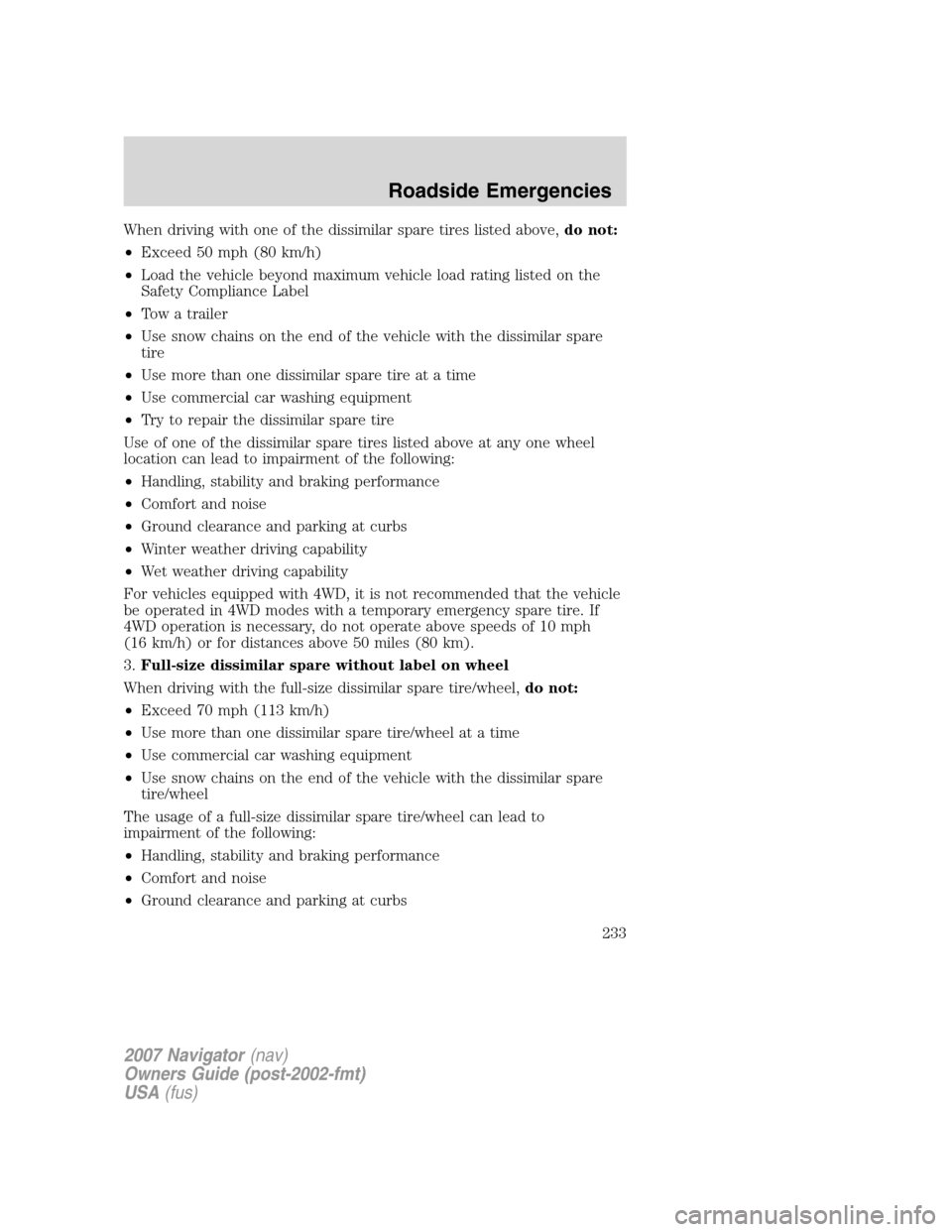
When driving with one of the dissimilar spare tires listed above,do not:
•Exceed 50 mph (80 km/h)
•Load the vehicle beyond maximum vehicle load rating listed on the
Safety Compliance Label
•Tow a trailer
•Use snow chains on the end of the vehicle with the dissimilar spare
tire
•Use more than one dissimilar spare tire at a time
•Use commercial car washing equipment
•Try to repair the dissimilar spare tire
Use of one of the dissimilar spare tires listed above at any one wheel
location can lead to impairment of the following:
•Handling, stability and braking performance
•Comfort and noise
•Ground clearance and parking at curbs
•Winter weather driving capability
•Wet weather driving capability
For vehicles equipped with 4WD, it is not recommended that the vehicle
be operated in 4WD modes with a temporary emergency spare tire. If
4WD operation is necessary, do not operate above speeds of 10 mph
(16 km/h) or for distances above 50 miles (80 km).
3.Full-size dissimilar spare without label on wheel
When driving with the full-size dissimilar spare tire/wheel,do not:
•Exceed 70 mph (113 km/h)
•Use more than one dissimilar spare tire/wheel at a time
•Use commercial car washing equipment
•Use snow chains on the end of the vehicle with the dissimilar spare
tire/wheel
The usage of a full-size dissimilar spare tire/wheel can lead to
impairment of the following:
•Handling, stability and braking performance
•Comfort and noise
•Ground clearance and parking at curbs
2007 Navigator(nav)
Owners Guide (post-2002-fmt)
USA(fus)
Roadside Emergencies
233
Page 234 of 312
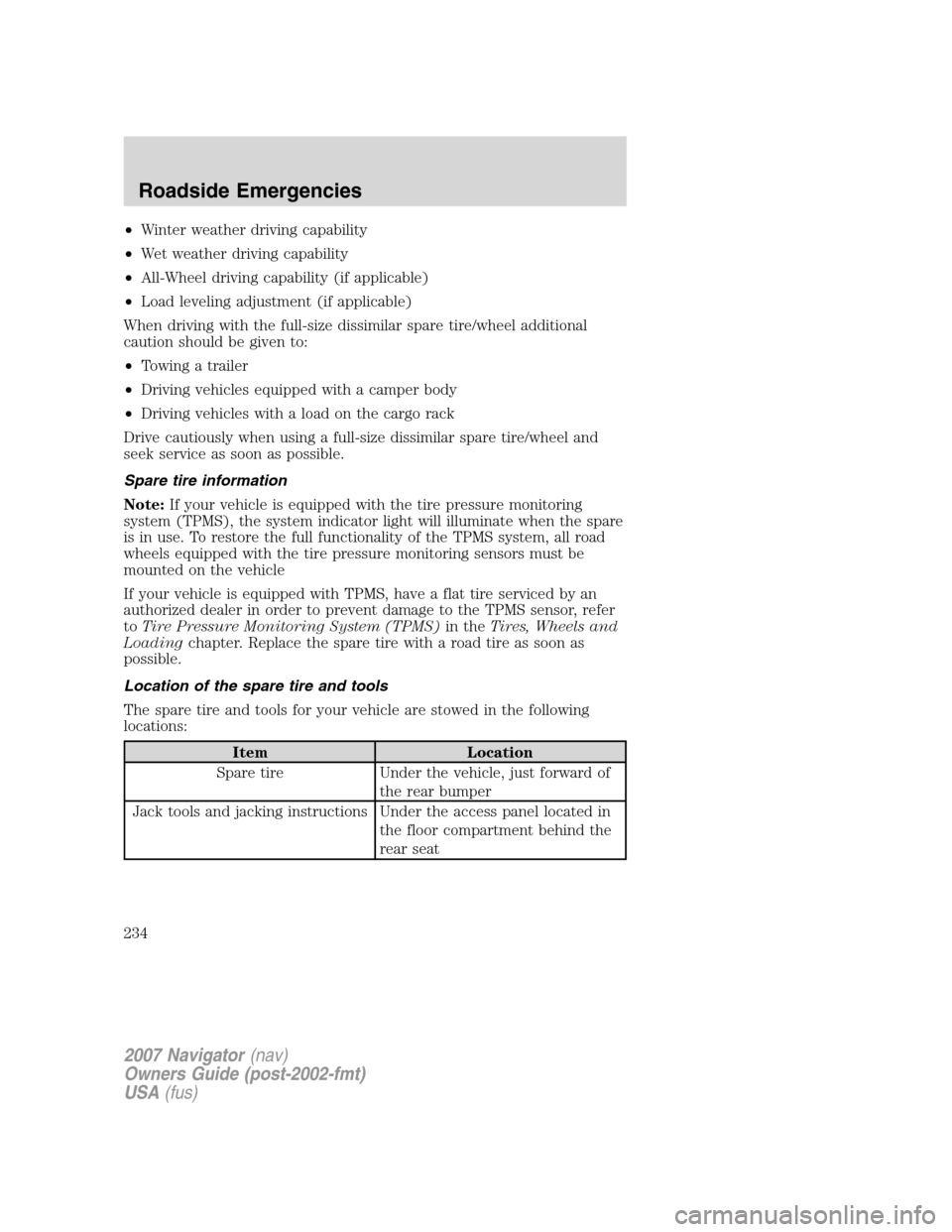
•Winter weather driving capability
•Wet weather driving capability
•All-Wheel driving capability (if applicable)
•Load leveling adjustment (if applicable)
When driving with the full-size dissimilar spare tire/wheel additional
caution should be given to:
•Towing a trailer
•Driving vehicles equipped with a camper body
•Driving vehicles with a load on the cargo rack
Drive cautiously when using a full-size dissimilar spare tire/wheel and
seek service as soon as possible.
Spare tire information
Note:If your vehicle is equipped with the tire pressure monitoring
system (TPMS), the system indicator light will illuminate when the spare
is in use. To restore the full functionality of the TPMS system, all road
wheels equipped with the tire pressure monitoring sensors must be
mounted on the vehicle
If your vehicle is equipped with TPMS, have a flat tire serviced by an
authorized dealer in order to prevent damage to the TPMS sensor, refer
toTire Pressure Monitoring System (TPMS)in theTires, Wheels and
Loadingchapter. Replace the spare tire with a road tire as soon as
possible.
Location of the spare tire and tools
The spare tire and tools for your vehicle are stowed in the following
locations:
Item Location
Spare tire Under the vehicle, just forward of
the rear bumper
Jack tools and jacking instructions Under the access panel located in
the floor compartment behind the
rear seat
2007 Navigator(nav)
Owners Guide (post-2002-fmt)
USA(fus)
Roadside Emergencies
234
Page 236 of 312

Tire change procedure
To help prevent the vehicle from moving when you change a tire,
be sure the parking brake is set, then block the wheels (both
front or both rear) on the opposite end of the vehicle from the wheel
being changed. If on a grade, block both opposite wheels on the
downward side of the hill.
If the vehicle slips off the jack, you or someone else could be
seriously injured.
On vehicles equipped with Air Suspension, turn OFF the Air
Suspension system prior to jacking, hoisting or towing your
vehicle.
If your vehicle is equipped with air suspension, refer toMessage center
in theDriver Controlschapter for instructions on turning the air
suspension system off.
Refer to the instruction sheet (located in the rear floor compartment
behind the 3rd row seat with the jack tray tools assembly kit) for
detailed tire change instructions.
1. Park on a level surface, activate
hazard flashers and set the parking
brake.
2007 Navigator(nav)
Owners Guide (post-2002-fmt)
USA(fus)
Roadside Emergencies
236